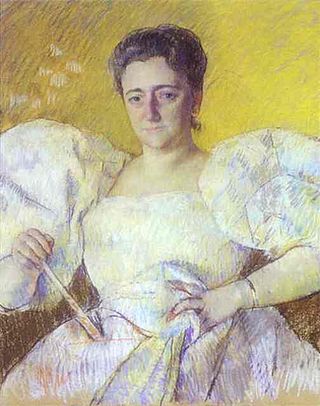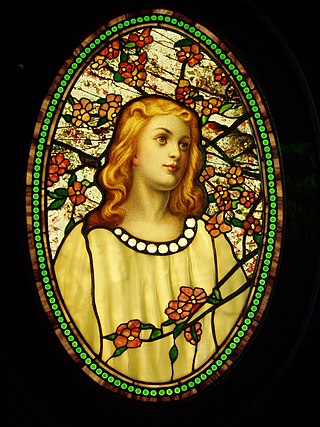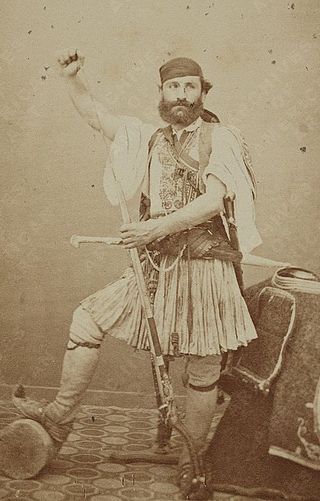
Louis Comfort Tiffany was an American artist and designer who worked in the decorative arts and is best known for his work in stained glass. He is the American artist most associated with the Art Nouveau and Aesthetic movements. He was affiliated with a prestigious collaborative of designers known as the Associated Artists, which included Lockwood de Forest, Candace Wheeler, and Samuel Colman. Tiffany designed stained glass windows and lamps, glass mosaics, blown glass, ceramics, jewellery, enamels, and metalwork. He was the first design director at his family company, Tiffany & Co., founded by his father Charles Lewis Tiffany.

Samuel Siegfried Bing, who usually gave his name as S. Bing, was a German-French art dealer who lived in Paris as an adult, and who helped introduce Japanese art and artworks to the West and was a factor in the development of the Art Nouveau style during the late nineteenth century.

The North Shore of Long Island is the area along the northern coast of New York's Long Island bordering Long Island Sound. Known for its extreme wealth and lavish estates, the North Shore exploded into affluence at the turn of the 20th century, earning it the nickname the Gold Coast. Historically, this term refers to the affluent coastline neighborhoods of the towns of North Hempstead and Oyster Bay in Nassau County and Huntington in Suffolk County. Some definitions may also include the parts of Smithtown that face the Sound. The region is also largely coextensive with the Gold Coast region of Long Island, though this region excludes Smithtown, as the easternmost Gold Coast mansion is the Geissler Estate, located just west of Indian Hills Country Club in the Fort Salonga section of Huntington.

The Charles Hosmer Morse Museum of American Art, a museum noted for its art nouveau collection, houses the most comprehensive collection of the works of Louis Comfort Tiffany found anywhere, a major collection of American art pottery, and fine collections of late-19th- and early-20th-century American paintings, graphics and the decorative arts. It is located in Winter Park, Florida.

Favrile glass is a type of iridescent art glass developed by Louis Comfort Tiffany. He patented this process in 1894 and first produced the glass for manufacture in 1896 in Queens, New York. It differs from most iridescent glasses because the color is ingrained in the glass itself, as well as having distinctive coloring. Tiffany won a grand prize at the 1900 Paris Exposition for his Favrile glass.
Kimon Nicolaїdes (1891–1938), was an American artist, educator, and author. During World War I, he served in the United States Army in France as a camouflage artist. He taught at the Art Students League of New York after the war. Nicolaїdes' book The Natural Way to Draw (1941) provided a new method of teaching drawing, and was widely used.

Jane Peterson (1876–1965) was an American Impressionist and Expressionist painter. Her works use broad swaths of vibrant colors to combine an interest in light and in the depiction of spontaneous moments. She painted still lives, beach scenes along the Massachusetts coast, and scenes from her extensive travels. Her works are housed in museums such as the Metropolitan Museum of Art, the Museum of the City of New York, the National Museum of Women in the Arts and the Hirshhorn Museum in Washington D.C., and the Pennsylvania Academy of the Fine Arts and the Philadelphia Museum of Art in Philadelphia, Pennsylvania. She was a fellow of the National Academy of Design and taught at the Art Students League from 1913 to 1919. During her lifetime, Peterson was featured in more than 80 one-woman exhibitions.

Louisine Waldron Elder Havemeyer was an art collector, feminist, and philanthropist. In addition to being a patron of impressionist art, she was one of the more prominent contributors to the suffrage movement in the United States. The impressionist painter Edgar Degas and feminist Alice Paul were among the renowned recipients of this benefactor's support.
The Louis Comfort Tiffany Foundation was founded in 1918 by Louis Comfort Tiffany to operate his estate, Laurelton Hall, in Cold Spring Harbor, Long Island. It was designed to be a summer retreat for artists and craftspeople. In 1946 the estate closed and the foundation changed its purpose from a retreat to the bestowing of grants to artists.

Clara Driscoll of Tallmadge, Ohio, was head of the Tiffany Studios Women's Glass Cutting Department, in New York City. Using patterns created from the original designs, these women selected and cut the glass to be used in the famous lamps. Driscoll designed more than thirty Tiffany lamps produced by Tiffany Studios, among them the Wisteria, Dragonfly, Peony, and from all accounts her first — the Daffodil.

Tiffany glass refers to the many and varied types of glass developed and produced from 1878 to 1933 at the Tiffany Studios in New York City, by Louis Comfort Tiffany and a team of other designers, including Clara Driscoll, Agnes F. Northrop, and Frederick Wilson.
Florence Nightingale Levy was an American arts administrator notable for founding of the publication American Art Annual in 1898.

Lockwood de Forest was an American painter, interior designer and furniture designer. A key figure in the Aesthetic Movement, he introduced the East Indian craft revival to Gilded Age America.
Jeannette Genius McKean (1909–1989) was a painter, interior decorator, Louis Comfort Tiffany art glass collector, Morse Museum founder and benefactor of Rollins College. She is listed as a Great Floridian. The Jeanette Genius McKean Memorial 5k run is held annually in her honor.

Frederick Wilson was a British stained glass artist best known for his work with Tiffany Studios. He was a prominent designer of ecclesiastical windows in the United States during the late 19th and early 20th centuries.
Virginia B. Evans was a West Virginia visual artist and teacher. In the Ohio Valley region she became famous for her impressionist painting and art deco glass work. Considered one of West Virginia's foremost artists of the 20th century, Evans was deemed “one of the best trained and most gifted painters” in the region by a renowned national art columnist.

Alice Carmen Gouvy was a designer at Tiffany Studios and worked closely with Clara Driscoll, the head of the Women's Glass Cutting Department.

Art Nouveau glass is fine glass in the Art Nouveau style. Typically the forms are undulating, sinuous and colorful art, usually inspired by natural forms. Pieces are generally larger than drinking glasses, and decorative rather than practical, other than for use as vases and lighting fittings; there is little tableware. Prominently makers, from the 1890s onwards, are in France René Lalique, Emile Gallé and the Daum brothers, the American Louis Comfort Tiffany, Christopher Dresser in Scotland and England, and Friedrich Zitzman, Karl Koepping and Max Ritter von Spaun in Germany. Art Nouveau glass included decorative objects, vases, lamps, and stained glass windows. It was usually made by hand, and was usually colored with metal oxides while in a molten state in a furnace.
















